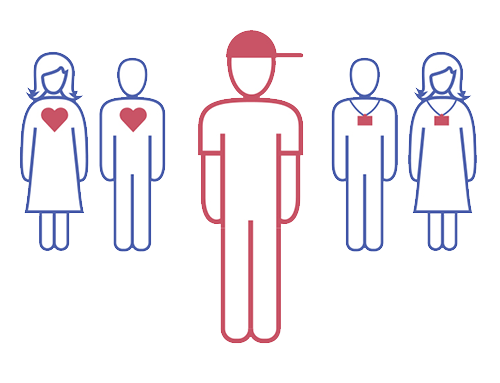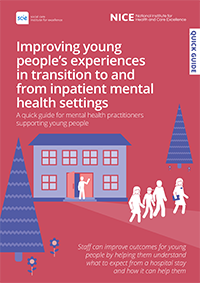A quick guide for mental health practitioners supporting young people
Transitions into and out of inpatient mental health settings are an important time for young people and their families.
Providing expert support and taking enough time to plan, particularly at discharge, can give them the best chance of recovery.
Staff can improve outcomes for young people by helping them understand what to expect from a hospital stay and how it can help them.
Planning for admission
Although not all admissions happen in a planned way, a young person is likely to have a better experience during an admission to an inpatient unit if you:
- Involve their parents, carers and any staff who support them.
- Take into account their family’s knowledge and expertise.
- Arrange for them to visit the unit if possible. If not, show them information and discuss it with them.
- Involve them in planning.
- Tell them about and help them use independent advocacy services.
Record a full history or update covering the young person’s cognitive, physical and mental health needs, current medication and support services as part of planning their admission.
Ongoing communication between the inpatient team and other teams involved in the young person’s care is essential, particularly when they are being admitted outside the area they live in.
Preparing for discharge
Thinking ahead to when they will leave the unit can help the young person prepare and avoid them feeling their discharge is too sudden or premature. In discussion with the young person and their parents or carers, consider:
Links with life outside the unit
What support do they need to stay in touch with family and friends and restart activities? Can they leave the unit for short periods? These links are particularly important if they have had a long stay or have been out of area.
Accommodation
Has there been a discussion about the young person’s housing and whether it is suitable for them to return to?
Education
Has a named worker been identified in their school or college and a meeting arranged with the young person to plan their return?
Peer support
Would the young person benefit from a group-based self-management training programme or direct support delivered by trained people with experience of using mental health services?
Fully involve the young person in a thorough assessment of their personal, social, safety and practical needs before discharge. This should include their risk of suicide. With their agreement, share this assessment with their parents or carers.

Care and support after discharge
A clearly written plan is fundamental to a successful discharge, including helping to avoid readmission. Work with the young person and their parents or carers to write a plan for their support once they leave the unit. Base the plan on the principles of recovery. Send a copy to everyone involved in supporting the young person within 24 hours of discharge.
The plan should include:
- where they will be discharged to
- the triggers that might cause a relapse and how to prevent it
- recovery goals and ways to manage their own condition
- ongoing treatment and support plan details
- who to contact for support
- where to go in a crisis
- budgeting and benefits, including personal budgets if appropriate
- social networks
- educational and social activities
- medication details
- any physical health needs, including health promotion and information about contraception
- review date
- what follow-up is required and preferred method of communication.
Crisis plan
If the young person has had more than 1 admission, help them to write a crisis plan as part of their care planning. Focus on what will help them to stay well and avoid further admissions, and include:
- possible signs that their mental health is deteriorating and what to do
- who to contact
- personal coping strategies
- any wishes they have about specific treatments or interventions.
Information and support for parents and carers
Parents and carers will need information and support too. Build good relationships with them and acknowledge that the admission can also be traumatic for them. The following may also help:

A named practitioner – to make sure parents and carers get the support and information they need, including about the purpose of admission, preparations for discharge, treatment, and local support services.

A carer’s assessment – offer 1 to anyone, including siblings, who will be supporting the young person.

Protected time – for parents to talk to practitioners.

Ongoing conversations – about the young person’s progress during their inpatient stay and how ready they are for discharge.

Discharge date – let parents and carers know well in advance.

Accommodating working patterns – to enable parents to attend planning meetings about care and discharge.
Useful links
- Young Minds provides a range of advice and guidance for young people, their parents, and mental health professionals.
- Helpful resources include Your Guide to Inpatient Care.
- Transition between inpatient mental health settings and community or care home settings (NICE guideline).
- Transition between inpatient mental health settings and community or care home settings (NICE quality standard).

Download this guide
We've created a copy of this guide that you can print and share:
This content has been co-produced by NICE and the Social Care Institute for Excellence (SCIE). It is based on NICE’s guideline and quality standard on transition between inpatient mental health settings and community or care home settings.